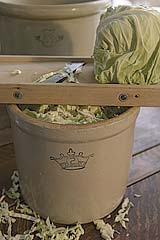|
My mother remembers sitting with her father on a porch swing every summer, cutting up green beans and putting them in a crock layered with salt. “That was how we got our veggies in the winter,” she remembers. The “sauer” in sauerkraut means cabbage, not “sour,” as in English. Fermented or lactic-acid vegetables have incredible taste and they keep us healthy and rejuvenated. I eat them on sandwiches, baked potatoes, eggs and salads. They’re low in calories and they’re super easy to digest. In fact, eaten with other foods, they help digest everything else you eat. Remember, if your food isn’t getting completely digested, you’re not getting the optimum amount of vitamins and minerals from the food you eat. It’s just passing through. Lactic-acid bacteria prevents decay, not only in food products, but in your intestines as well. Lactic-acid bacteria are present on most plants as surface culture, but their numbers are diminished shortly after a rain storm. So, don’t harvest vegetables destined for preservation for a day or so after a rain storm. |
|
The history of fermented vegetables goes back to 50 AD. Remember Captain Cook’s travels in the eighteenth century? He sailed around the world without losing a single crew member to scurvy because of the fermented vegetables they had on board. I have successfully fermented the following vegetables: beets |


I like to dream up my recipes as I go along, based on what I have on hand. If I’m blending carrots, garlic and celery, maybe I’ll add a few greens like kale or tat soi along with some mustard, coriander or caraway seeds. Don’t forget herbs and spices. Can you imagine dill pickles without the dill?
If you need to use chlorinated tap water, you have to filter it before you use it to rinse your vegetables. Chlorine kills both bad and good bacteria. If you kill the good bacteria found naturally on vegetables, nasty molds such as yeast and things like butyric acid will take hold. If your vegetables didn’t process properly, you’ll know it the minute you check your crock after a month or so. Like waiting until Christmas to open presents, it’s important not to open the crock before the end of fermentation. If you do, the carbon dioxide that prevents yeast formation will escape. Always use super clean hands and utensils when preparing vegetables for fermentation.
Classic Sauerkraut
Remove the outer leaves and any undesirable portions from firm, mature heads of cabbage; wash and drain. Cut into halves or quarters; remove the core. Use a shredder or sharp knife to cut the cabbage into shreds.
In a large container, thoroughly mix 3 tablespoons sea salt with 5 pounds shredded cabbage (or 2 teaspoons per 1 quart). Let the salted cabbage stand for several minutes to wilt slightly; this allows packing without excessive breaking or bruising of the shreds.
Pack the salted cabbage firmly and evenly into a clean crock or jar. Using a wooden spoon or clean hands, press down firmly until the juice comes to the surface. Repeat the shredding, salting and packing of cabbage until the crock is filled to within 4 or 5 inches of the top.
Place a thick food-grade plastic bag filled with water on top of the fermenting cabbage. The water-filled bag seals the surface from exposure to air, and prevents the growth of film yeast or molds. It also serves as a weight. For extra protection, the bag with water in it can be placed inside another plastic bag. The amount of water in the plastic bag can be adjusted to give just enough pressure to keep the fermenting cabbage covered with brine.
Formation of gas bubbles indicates fermentation is taking place. A room temperature of 68 to 72° is best for fermenting cabbage. Fermentation is usually completed in 5 to 6 weeks.
After fermentation is completed, pack it in clean glass jars. If the jar has a metal lid, line it with clear plastic or wax paper before you screw it on.
My sauerkraut keeps “forever” in my fridge. Some of my gallon glass jars of sauerkraut have lasted a year or more under constant refrigeration.
Find more simple solutions in MaryJanesFarm magazine. Click here to find out how to order your copy today.
